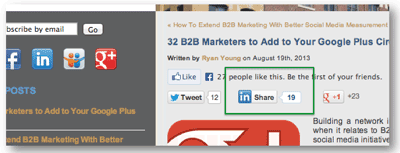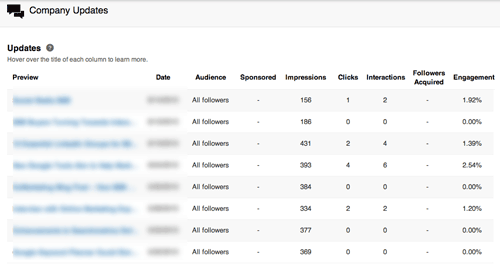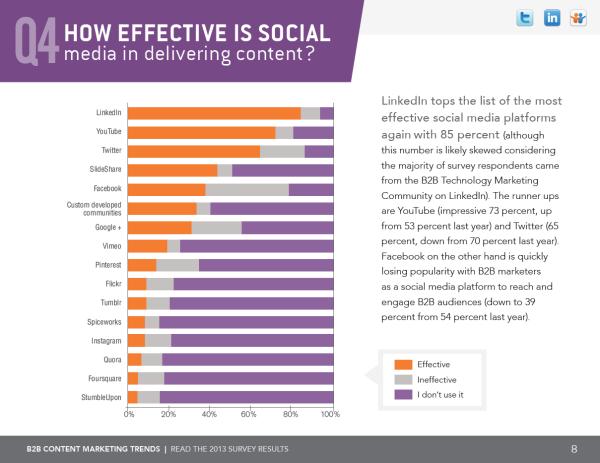4 LinkedIn Recommendations For The B2B SEO Professional
LinkedIn’s recent announcement about the redesign of LinkedIn Group pages has had me thinking much more about why B2B search marketers need to leverage this social media platform in support of SEO initiatives. According to the announcement, “there are more than 200 conversations happening each minute across LinkedIn Groups and more than 8,000 Groups created […]
According to the announcement, “there are more than 200 conversations happening each minute across LinkedIn Groups and more than 8,000 Groups created each week.” And in Holger Schulze’s 2013 B2B Content Marketing Trends Report, LinkedIn tops the list as the most effective social media platform for delivering content.
Schultze acknowledges a bias in these findings (since those polled were from the LinkedIn B2B technology marketing community). However, similar research from the Content Marketing Institute and GlobalSpec supports this notion as well.
Yet LinkedIn has historically been overlooked by SEOs in favor of other social media platforms — even in the B2B sector.
Why has this been the case?
- Links in profiles and discussions aren’t really SEO friendly. LinkedIn incorporates 302 redirects and nofollow syntax in the majority of link references.
- We don’t see LinkedIn discussions and/or Web addresses appear often enough in search engine results for strategic keyword targets to warrant more focused attention.
Taking these two components into consideration, it makes sense that businesses would view other social media initiatives (like Google+, Twitter, blogging, etc.) as more valuable.
But this misconception needs to change, especially for B2B search marketing professionals. Following are some key LinkedIn initiatives B2B SEOs need to consider adopting for their search engine marketing strategy.
Network, Network, Network
There was a time when SEOs didn’t necessarily need to network to gain links for the sites they managed. Google has changed that game quite a bit. For B2B SEOs to succeed at link acquisition, they need to develop partnerships and connections with industry peers and influencers. LinkedIn is a logical place to foster growth in your professional network.
Below are some ideas and ways to get started:
- A complete profile is a must for establishing initial credibility including head shot, professional bio and work experience, but also skills, publications, interests, and organizational affiliations.
- Join groups and contribute appropriately within the rules and guidelines of group moderators and in a productive manner. Link dropping for SEO doesn’t matter here, and your personal brand and reputation is at stake.
- Add productive comments to LinkedIn articles that are relevant and applicable to your areas of interest and expertise in an effort to gain awareness.
- Research industry conferences and events for relevant publications for link outreach and monitor/seek to contribute in LinkedIn discussions and groups key members of those publications are associated with.
- Don’t forget to network in real life as well. Make sure to connect and stay in communication with people you meet at networking events, trade shows, etc.
As your network builds and your contributions in the community become more visible, LinkedIn members will endorse your profile via LinkedIn endorsements and (hopefully) full recommendations. As you build trust in the community, hopefully doors open to discussing ways to acquire links through content marketing efforts and more strategic business discussions.
Incorporate LinkedIn Share Buttons
I enjoy LinkedIn Today, and while it’s difficult to know exactly what factors enable article content to rank well per category and in personalized results, making your article content easy to share on LinkedIn (by adding LinkedIn share buttons) is a good first step.

How do you set up a LinkedIn share button? LinkedIn offers a fairly simple set of code instructions for developing share buttons on your Web pages and blog posts.
Fortunately, the code is pretty easy to absorb and only takes minor knowledge of HTML and scripting to integrate into typical Web page templates.
Note: Greg Finn wrote a column a couple years back on optimizing your content for LinkedIn Today, and while some of the information and screenshots are dated, the column is worth reviewing.
Build Out Your Company Page
B2B buyers want to know about the companies they are considering purchasing from. According to data from Eloqua, 75% of B2B buyers claimed that social media would likely have influence on future purchasing decisions. In the 2012 B2B Buyer Behavior Survey from the Demand Gen Report, 72% of our respondents said they used social media to research their solution purchase.
While most organizations understand the opportunity these pages have for job postings, LinkedIn company pages are also a great place to consolidate and curate information — both company owned and industry/buyer relevant. A well connected (followed) company profile helps expand the reach of important B2B content marketing initiatives.
Some key starting points for LinkedIn Company Pages:
- Comprehensiveness: Make sure to complete as much company information as possible, including description, address information and specialties (which can function like keyword tags for identification purposes).
- Graphics & Photos: Cover photos represent a huge opportunity to catch the visitor’s eye and draw them in to click deeper into page elements.
- Services & Recommendations: Recommendations in the services section of the page can help establish trust and build brand reputation.
- Consistent Posting: Create an editorial calendar of updates — company owned and highlighting relevant third party material — to share with company followers
- Dynamic Communication: LinkedIn offers the ability to add video introductions through YouTube and to target visitors by language. These could be key differentiating factors when building out an organization’s Linkedin presence.
I recommend checking out LinkedIn’s guide to company pages to learn more about features and opportunities. Once your page is established don’t forget to regularly monitor LinkedIn Page Insights and Analytics to learn more about your audience and the content visitors tend to consume most.

About LinkedIn Groups
The great thing about LinkedIn Groups is in the opportunity to engage in productive and educational discussions on topics relevant to your industry and expertise. Because groups have fairly effective moderating settings at the member and discussion levels, active group managers can enable better quality control of spam, with the goal of improving the experience for all group members.
I like how the new groups interface will highlight influential members and popular discussions in a more intuitive fashion. But the heavy lifting is up to group members to provide important discussions and material justifying the labels of “popular” and “influential.”
When considering whether the time investment in group participation makes sense, some factors I recommend evaluating are:
- Discussion activity, frequency and direction: How well is group moderating facilitating productive discussions and information exchanges?
- Member level and activity: Are LinkedIn members contributing in discussion creation and contribution?
- Member involvement: Are there members of the group that provide the opportunity for link acquisition through content marketing efforts and other strategic initiatives?
For B2B SEO professionals, LinkedIn groups provide a distinct opportunity to network, build connections personally and for link outreach, and generate awareness for the organization and personal brand.
Is LinkedIn Part Of Your SEO Strategy?
As link building becomes a much more “relationship-centric” initiative, SEO professionals need to focus on communities and locations where networks can be developed and nurtured. While B2B marketers regard LinkedIn as the optimal social media platform for content delivery and brand communication, SEO professionals can build connections designed to acquire links through content and expand the reach of content marketing assets.
Does LinkedIn make up a component of your B2B SEO strategy? I would like to read your perspective via comments below.

